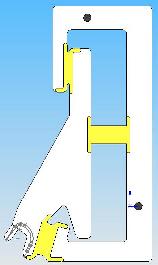new web: http://bdml.stanford.edu/pmwiki
TWiki > Rise Web>TWikiUsers > LaurelFullerton>PositiveNormalForceSpines (28 Aug 2008, LaurelFullerton)
Rise Web>TWikiUsers > LaurelFullerton>PositiveNormalForceSpines (28 Aug 2008, LaurelFullerton)
Positive Normal Force Spines
Positive normal force spines are spines that that are loaded by pushing into the wall rather than hanging back from it. On a human climber, they would be attached to the feet or knees while negative normal force spines (Jacobi toes, etc.) would be used for the hands.Version 1 Design
After much modeling in Working Model, a spine that works with positive normal force has been developed. In order for this spine to attach to the wall, it must be loaded in pure shear or with positive normal force. Any normal force directed away from the wall will cause it to peel off. The Working Model simulation of this design may be found on Yoda at: \\Yoda\Users\laurelf\Positive Normal Force\_V1spine\V1_0N.wm2d A slightly different version has also been developed. This design balances perfectly with 10 Newtons of shear force and 1 Newton of normal force. Any normal forces of less than 1 Newton will cause the spine to peel off of the wall. Working Model simulations of this design are also on Yoda: \\Yoda\Users\laurelf\Positive Normal Force\_V1spine\V1_1N.wm2dPreliminary Results
After a brief discussion with AlanAsbeck, it was determined that the designs above did not have enough horizontal travel. When loaded, those designs can only travel 3 mm before they jam internally. Ideally there would be about a centimeter of horizontal travel. The minimum acceptable distance is 7 mm.-- LaurelFullerton - 01 Aug 2008
Version 2 Design
A design that meets the horizontal travel distance requirement is in the works. A preliminary version of this design may be found on Yoda at: \\Yoda\Users\laurelf\Positive Normal Force\_V2spine\V2_preliminary.wm2d-- LaurelFullerton - 04 Aug 2008 The Working Model simulation has been tweaked a bit in order to ease the transition to SolidWorks. The positions of spring end points were set to known values. These values were then marked in a SolidWorks sketch ensuring that the manufactured part will have the same spring and spine positions as the simulation. The modified simulation may be found on Yoda at: \\Yoda\Users\laurelf\Positive Normal Force\_V2spine\V2_dimensioned.wm2d

-- LaurelFullerton - 06 Aug 2008 The spines built from the SolidWorks model do not behave the way the Working Model predicts they will. The main contributing factor to this difference is that springs in Working Model always connect to the bodies via pin joints. The actual spines do not behave in this manner and feel rather stiff. The bottom flexure of the spines has been removed which allows the spine to better conform to the wall. The spines are still too stiff in the shear direction. The next iteration should probably have no bottom flexure and a much longer (softer) top flexure.
-- LaurelFullerton - 28 Aug 2008
Future Work
The Version 2 Design will be updated to take advantage of the lessons learned by the first design iteration. Also, I will look into Working Model to see if there is a way to attach springs with rigid joints.-- LaurelFullerton - 28 Aug 2008
Ideas, requests, problems regarding TWiki? Send feedback